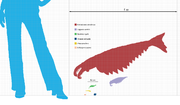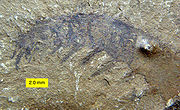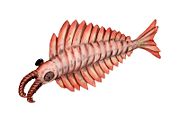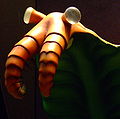
Anomalocaris
Encyclopedia
Anomalocaris is an extinct genus of anomalocaridid, which are, in turn, thought to be closely related to the arthropod
s. The first fossil
s of Anomalocaris were discovered in the Ogygopsis Shale by Joseph Frederick Whiteaves
, with more examples found by Charles Doolittle Walcott
in the famed Burgess Shale
. Originally several fossilized parts discovered separately (the mouth, feeding appendages and tail) were thought to be three separate creatures, a misapprehension corrected by Harry B. Whittington
and Derek Briggs
in a 1985 journal article
.
 Anomalocaris is thought to have been a predator
Anomalocaris is thought to have been a predator
. It propelled itself through the water by undulating the flexible lobes on the sides of its body. Each lobe sloped below the one more posterior to it, and this overlapping allowed the lobes on each side of the body to act as a single "fin", maximising the swimming efficiency. The construction of a remote-controlled model showed this mode of swimming to be intrinsically stable, meaning that Anomalocaris need not have had a complex brain to cope with balancing while swimming. The widest part of the body was on the third to fifth lobe; it narrowed towards its tail, and had at least 11 lobes in total. The more posterior lobes are difficult to discriminate, making an accurate count difficult. Anomalocaris had a large head, a single pair of large, possibly compound eye
s, and an unusual, disk-like mouth
. The mouth was composed of 32 overlapping plates, four large and 28 small, resembling a pineapple
ring with the center replaced by a series of serrated
prongs. The mouth could constrict to crush prey, but never completely close, and the tooth-like prongs continued down the walls of the gullet
. Two large 'arms' (up to seven inches in length when extended) with barb-like spikes were positioned in front of the mouth. The tail was large and fan-shaped, and along with undulations of the lobes, was probably used to propel the creature through Cambrian waters. Stacked lamella of what were probably gill
s attached to the top of each lobe
.
For the time in which it lived Anomalocaris was a truly gigantic creature, reaching lengths of up to one meter.
 Anomalocaris has been misidentified several times, in part due to its makeup of a mixture of mineralized
Anomalocaris has been misidentified several times, in part due to its makeup of a mixture of mineralized
and unmineralized body parts; the mouth and feeding appendage was considerably harder and more easily fossilized than the delicate body. Its name originates from a description of a detached 'arm', described by Joseph Frederick Whiteaves
in 1892 as a separate crustacean
-like creature due to its resemblance to the tail of a lobster
or shrimp
. The first fossilized mouth was discovered by Charles Doolittle Walcott
, who mistook it for a jellyfish
and placed it in the genus Peytoia. Walcott also discovered a second feeding appendage but failed to realize the similarities to Whiteaves' discovery and instead identified it as feeding appendage or tail of the extinct Sidneyia
. The body was discovered separately and classified as a sponge in the genus Laggania; the mouth was found with the body, but was interpreted by its discoverer Simon Conway Morris
as an unrelated Peytoia that had through happenstance settled and been preserved with Laggania. Later, while clearing what he thought was an unrelated specimen, Harry B. Whittington
removed a layer of covering stone to discover the unequivocally connected arm thought to be a shrimp tail and mouth thought to be a jellyfish. Whittington linked the two species, but it took several more years for researchers to realize that the continuously juxtaposed Peytoia, Laggania and feeding appendage actually represented a single, enormous creature. According to International Commission on Zoological Nomenclature
rules, the oldest name takes priority, which in this case would be Anomalocaris. The name Laggania
was later used for another genus of anomalocarid. "Peytoia" has been modified into Parapeytoia
, a genus of Chinese anomalocarid. Anomalocaris is placed in the extinct family Anomalocaridae, and is now considered to be related to modern arthropod
s.
Stephen Jay Gould
cites Anomalocaris as one of the fossilized extinct species he believed to be evidence of a much more diverse set of phyla
that existed in the Cambrian
era (discussed in his book Wonderful Life
), a conclusion disputed by other paleontologists.

 Anomalocaris had a cosmopolitan distribution in Cambrian seas, and has been found from early to mid Cambrian deposits from Canada, China, Utah and Australia, to name but a few.
Anomalocaris had a cosmopolitan distribution in Cambrian seas, and has been found from early to mid Cambrian deposits from Canada, China, Utah and Australia, to name but a few.
A long-standing view holds that Anomalocaris fed on hard-bodied animals, including trilobites. While its mid-gut glands strongly suggest a predatory lifestyle, its ability to penetrate mineralised shells has come under fire in recent years. Some Cambrian trilobites have been found with round or W-shaped "bite" marks, which were identified in shape with the mouthparts of Anomalocaris.
Stronger evidence that Anomalocaris ate trilobites comes from fossilised faecal pellets
, which contain trilobite parts and are so large that the anomalocarids are the only organisms large enough to have produced them. However, since Anomalocaris lacks any mineralised tissue, it seemed unlikely that it would be able to penetrate the hard, calcified shell of trilobites.
One possibility is that anomalocarids fed by grabbing one end of their prey in their jaws while using their appendages to quickly rock the other end of the animal back and forth. This produced stresses that exploited the weaknesses of arthropod cuticle, causing the prey's exoskeleton to rupture and allowing the predator to access its innards. This behaviour is thought to have provided an evolutionary pressure for trilobites to roll up, to avoid being flexed until they snapped. However, the lack of wear on anomalocarid mouthparts suggests they did not come into regular contact with mineralised trilobite shells. Computer modeling of the Anomalocaris mouthparts suggests they were in fact better suited to sucking on smaller, soft-bodied organisms (and could not have been responsible for many trilobite deformations).
Arthropod
An arthropod is an invertebrate animal having an exoskeleton , a segmented body, and jointed appendages. Arthropods are members of the phylum Arthropoda , and include the insects, arachnids, crustaceans, and others...
s. The first fossil
Fossil
Fossils are the preserved remains or traces of animals , plants, and other organisms from the remote past...
s of Anomalocaris were discovered in the Ogygopsis Shale by Joseph Frederick Whiteaves
Joseph Frederick Whiteaves
Joseph Frederick Whiteaves , was a British palaeontologist.Born in Oxford, Whiteaves was educated at private schools, and afterwards worked under John Phillips at Oxford ; he was led to study the Oolitic rocks, and added largely to our knowledge of the fossils of the Great Oolite series, Cornbrash...
, with more examples found by Charles Doolittle Walcott
Charles Doolittle Walcott
Charles Doolittle Walcott was an American invertebrate paleontologist. He became known for his discovery in 1909 of well-preserved fossils in the Burgess Shale of British Columbia, Canada.-Early life:...
in the famed Burgess Shale
Burgess Shale
The Burgess Shale Formation, located in the Canadian Rockies of British Columbia, is one of the world's most celebrated fossil fields, and the best of its kind. It is famous for the exceptional preservation of the soft parts of its fossils...
. Originally several fossilized parts discovered separately (the mouth, feeding appendages and tail) were thought to be three separate creatures, a misapprehension corrected by Harry B. Whittington
Harry B. Whittington
Harry Blackmore Whittington FRS was a British paleontologist based at the Department of Earth Sciences, Cambridge, and was affiliated to Sidney Sussex College. He attended Handsworth Grammar School in Birmingham, followed by a degree and Ph.D in geology from the University of Birmingham...
and Derek Briggs
Derek Briggs
Derek Ernest Gilmor Briggs is an Irish paleontologist and taphonomist based at Yale University. Briggs is one of three paleontologists who were key in the reinterpretation of the fossils of the Burgess Shale.-Professional achievements:...
in a 1985 journal article
Scientific journal
In academic publishing, a scientific journal is a periodical publication intended to further the progress of science, usually by reporting new research. There are thousands of scientific journals in publication, and many more have been published at various points in the past...
.
Anatomy

Predation
In ecology, predation describes a biological interaction where a predator feeds on its prey . Predators may or may not kill their prey prior to feeding on them, but the act of predation always results in the death of its prey and the eventual absorption of the prey's tissue through consumption...
. It propelled itself through the water by undulating the flexible lobes on the sides of its body. Each lobe sloped below the one more posterior to it, and this overlapping allowed the lobes on each side of the body to act as a single "fin", maximising the swimming efficiency. The construction of a remote-controlled model showed this mode of swimming to be intrinsically stable, meaning that Anomalocaris need not have had a complex brain to cope with balancing while swimming. The widest part of the body was on the third to fifth lobe; it narrowed towards its tail, and had at least 11 lobes in total. The more posterior lobes are difficult to discriminate, making an accurate count difficult. Anomalocaris had a large head, a single pair of large, possibly compound eye
Eye
Eyes are organs that detect light and convert it into electro-chemical impulses in neurons. The simplest photoreceptors in conscious vision connect light to movement...
s, and an unusual, disk-like mouth
Mouth
The mouth is the first portion of the alimentary canal that receives food andsaliva. The oral mucosa is the mucous membrane epithelium lining the inside of the mouth....
. The mouth was composed of 32 overlapping plates, four large and 28 small, resembling a pineapple
Pineapple
Pineapple is the common name for a tropical plant and its edible fruit, which is actually a multiple fruit consisting of coalesced berries. It was given the name pineapple due to its resemblance to a pine cone. The pineapple is by far the most economically important plant in the Bromeliaceae...
ring with the center replaced by a series of serrated
Serrated blade
A serrated blade is a type of blade used on saws and on some knives or scissors. It is also known as a dentated, sawtooth, or toothed blade.A serrated blade has a cutting edge that has many small points of contact with the material being cut...
prongs. The mouth could constrict to crush prey, but never completely close, and the tooth-like prongs continued down the walls of the gullet
Esophagus
The esophagus is an organ in vertebrates which consists of a muscular tube through which food passes from the pharynx to the stomach. During swallowing, food passes from the mouth through the pharynx into the esophagus and travels via peristalsis to the stomach...
. Two large 'arms' (up to seven inches in length when extended) with barb-like spikes were positioned in front of the mouth. The tail was large and fan-shaped, and along with undulations of the lobes, was probably used to propel the creature through Cambrian waters. Stacked lamella of what were probably gill
Gill
A gill is a respiratory organ found in many aquatic organisms that extracts dissolved oxygen from water, afterward excreting carbon dioxide. The gills of some species such as hermit crabs have adapted to allow respiration on land provided they are kept moist...
s attached to the top of each lobe
Lobe (anatomy)
In anatomy, a lobe is a clear anatomical division or extension that can be determined without the use of a microscope This is in contrast to a lobule, which is a clear division only visible histologically....
.
For the time in which it lived Anomalocaris was a truly gigantic creature, reaching lengths of up to one meter.
Discovery

Mineralization (biology)
In biology, mineralization refers to the process where an organic substance is converted to an inorganic substance.This may also be a normal biological process which takes place during the life of an organism such as the formation of bone tissue or egg shells, largely with calcium.This term may...
and unmineralized body parts; the mouth and feeding appendage was considerably harder and more easily fossilized than the delicate body. Its name originates from a description of a detached 'arm', described by Joseph Frederick Whiteaves
Joseph Frederick Whiteaves
Joseph Frederick Whiteaves , was a British palaeontologist.Born in Oxford, Whiteaves was educated at private schools, and afterwards worked under John Phillips at Oxford ; he was led to study the Oolitic rocks, and added largely to our knowledge of the fossils of the Great Oolite series, Cornbrash...
in 1892 as a separate crustacean
Crustacean
Crustaceans form a very large group of arthropods, usually treated as a subphylum, which includes such familiar animals as crabs, lobsters, crayfish, shrimp, krill and barnacles. The 50,000 described species range in size from Stygotantulus stocki at , to the Japanese spider crab with a leg span...
-like creature due to its resemblance to the tail of a lobster
Lobster
Clawed lobsters comprise a family of large marine crustaceans. Highly prized as seafood, lobsters are economically important, and are often one of the most profitable commodities in coastal areas they populate.Though several groups of crustaceans are known as lobsters, the clawed lobsters are most...
or shrimp
Shrimp
Shrimp are swimming, decapod crustaceans classified in the infraorder Caridea, found widely around the world in both fresh and salt water. Adult shrimp are filter feeding benthic animals living close to the bottom. They can live in schools and can swim rapidly backwards. Shrimp are an important...
. The first fossilized mouth was discovered by Charles Doolittle Walcott
Charles Doolittle Walcott
Charles Doolittle Walcott was an American invertebrate paleontologist. He became known for his discovery in 1909 of well-preserved fossils in the Burgess Shale of British Columbia, Canada.-Early life:...
, who mistook it for a jellyfish
Jellyfish
Jellyfish are free-swimming members of the phylum Cnidaria. Medusa is another word for jellyfish, and refers to any free-swimming jellyfish stages in the phylum Cnidaria...
and placed it in the genus Peytoia. Walcott also discovered a second feeding appendage but failed to realize the similarities to Whiteaves' discovery and instead identified it as feeding appendage or tail of the extinct Sidneyia
Sidneyia
Sidneyia is an extinct arthropod known from fossils found in the Cambrian-age Burgess Shale formation of British Columbia. -General description:...
. The body was discovered separately and classified as a sponge in the genus Laggania; the mouth was found with the body, but was interpreted by its discoverer Simon Conway Morris
Simon Conway Morris
Simon Conway Morris FRS is an English paleontologist made known by his detailed and careful study of the Burgess Shale fossils, an exploit celebrated in Wonderful Life by Stephen Jay Gould...
as an unrelated Peytoia that had through happenstance settled and been preserved with Laggania. Later, while clearing what he thought was an unrelated specimen, Harry B. Whittington
Harry B. Whittington
Harry Blackmore Whittington FRS was a British paleontologist based at the Department of Earth Sciences, Cambridge, and was affiliated to Sidney Sussex College. He attended Handsworth Grammar School in Birmingham, followed by a degree and Ph.D in geology from the University of Birmingham...
removed a layer of covering stone to discover the unequivocally connected arm thought to be a shrimp tail and mouth thought to be a jellyfish. Whittington linked the two species, but it took several more years for researchers to realize that the continuously juxtaposed Peytoia, Laggania and feeding appendage actually represented a single, enormous creature. According to International Commission on Zoological Nomenclature
International Commission on Zoological Nomenclature
The International Commission on Zoological Nomenclature is an organization dedicated to "achieving stability and sense in the scientific naming of animals". Founded in 1895, it currently comprises 28 members from 20 countries, mainly practicing zoological taxonomists...
rules, the oldest name takes priority, which in this case would be Anomalocaris. The name Laggania
Laggania
Laggania cambria was a species of Anomalocarid that lived in the Cambrian period. Its two mouth appendages had long bristle-like spines, it had no fan tail, and its short stalked eyes were behind its mouth appendages...
was later used for another genus of anomalocarid. "Peytoia" has been modified into Parapeytoia
Parapeytoia
Parapeytoia was a prehistoric animal that lived over 530 million years ago that lived in Maotianshan shales of prehistoric China. Like the anomalocarids that it resembled , Parapeytoia had two head appendages in front of the also anomalocarid like round mouth, eyes on stalks, and fleshy lobed...
, a genus of Chinese anomalocarid. Anomalocaris is placed in the extinct family Anomalocaridae, and is now considered to be related to modern arthropod
Arthropod
An arthropod is an invertebrate animal having an exoskeleton , a segmented body, and jointed appendages. Arthropods are members of the phylum Arthropoda , and include the insects, arachnids, crustaceans, and others...
s.
Stephen Jay Gould
Stephen Jay Gould
Stephen Jay Gould was an American paleontologist, evolutionary biologist, and historian of science. He was also one of the most influential and widely read writers of popular science of his generation....
cites Anomalocaris as one of the fossilized extinct species he believed to be evidence of a much more diverse set of phyla
Phylum
In biology, a phylum The term was coined by Georges Cuvier from Greek φῦλον phylon, "race, stock," related to φυλή phyle, "tribe, clan." is a taxonomic rank below kingdom and above class. "Phylum" is equivalent to the botanical term division....
that existed in the Cambrian
Cambrian
The Cambrian is the first geological period of the Paleozoic Era, lasting from Mya ; it is succeeded by the Ordovician. Its subdivisions, and indeed its base, are somewhat in flux. The period was established by Adam Sedgwick, who named it after Cambria, the Latin name for Wales, where Britain's...
era (discussed in his book Wonderful Life
Wonderful Life (book)
Wonderful Life: The Burgess Shale and the Nature of History is a book on the evolution of Cambrian fauna by Harvard paleontologist Stephen Jay Gould...
), a conclusion disputed by other paleontologists.
Ecology


A long-standing view holds that Anomalocaris fed on hard-bodied animals, including trilobites. While its mid-gut glands strongly suggest a predatory lifestyle, its ability to penetrate mineralised shells has come under fire in recent years. Some Cambrian trilobites have been found with round or W-shaped "bite" marks, which were identified in shape with the mouthparts of Anomalocaris.
Stronger evidence that Anomalocaris ate trilobites comes from fossilised faecal pellets
Coprolite
A coprolite is fossilized animal dung. Coprolites are classified as trace fossils as opposed to body fossils, as they give evidence for the animal's behaviour rather than morphology. The name is derived from the Greek words κοπρος / kopros meaning 'dung' and λιθος / lithos meaning 'stone'. They...
, which contain trilobite parts and are so large that the anomalocarids are the only organisms large enough to have produced them. However, since Anomalocaris lacks any mineralised tissue, it seemed unlikely that it would be able to penetrate the hard, calcified shell of trilobites.
One possibility is that anomalocarids fed by grabbing one end of their prey in their jaws while using their appendages to quickly rock the other end of the animal back and forth. This produced stresses that exploited the weaknesses of arthropod cuticle, causing the prey's exoskeleton to rupture and allowing the predator to access its innards. This behaviour is thought to have provided an evolutionary pressure for trilobites to roll up, to avoid being flexed until they snapped. However, the lack of wear on anomalocarid mouthparts suggests they did not come into regular contact with mineralised trilobite shells. Computer modeling of the Anomalocaris mouthparts suggests they were in fact better suited to sucking on smaller, soft-bodied organisms (and could not have been responsible for many trilobite deformations).
See also
- Anomalocarididae, the classification group of anomalocaris
- Cambrian explosionCambrian explosionThe Cambrian explosion or Cambrian radiation was the relatively rapid appearance, around , of most major phyla, as demonstrated in the fossil record, accompanied by major diversification of other organisms, including animals, phytoplankton, and calcimicrobes...
- OpabiniaOpabiniaOpabinia is an animal genus found in Cambrian fossil deposits. Its sole species, Opabinia regalis, is known from the Middle Cambrian Burgess Shale of British Columbia, Canada. Fewer than twenty good specimens have been described; 3 specimens of Opabinia are known from the Greater Phyllopod bed,...
- WiwaxiaWiwaxiaWiwaxia is a genus of soft-bodied, scale-covered animals known from Burgess shale type Lagerstätte dating from the upper Lower Cambrian to Middle Cambrian. The organisms are mainly known from dispersed sclerites; articulated specimens, where found, range from to a little over 50.8 millimeters in...

